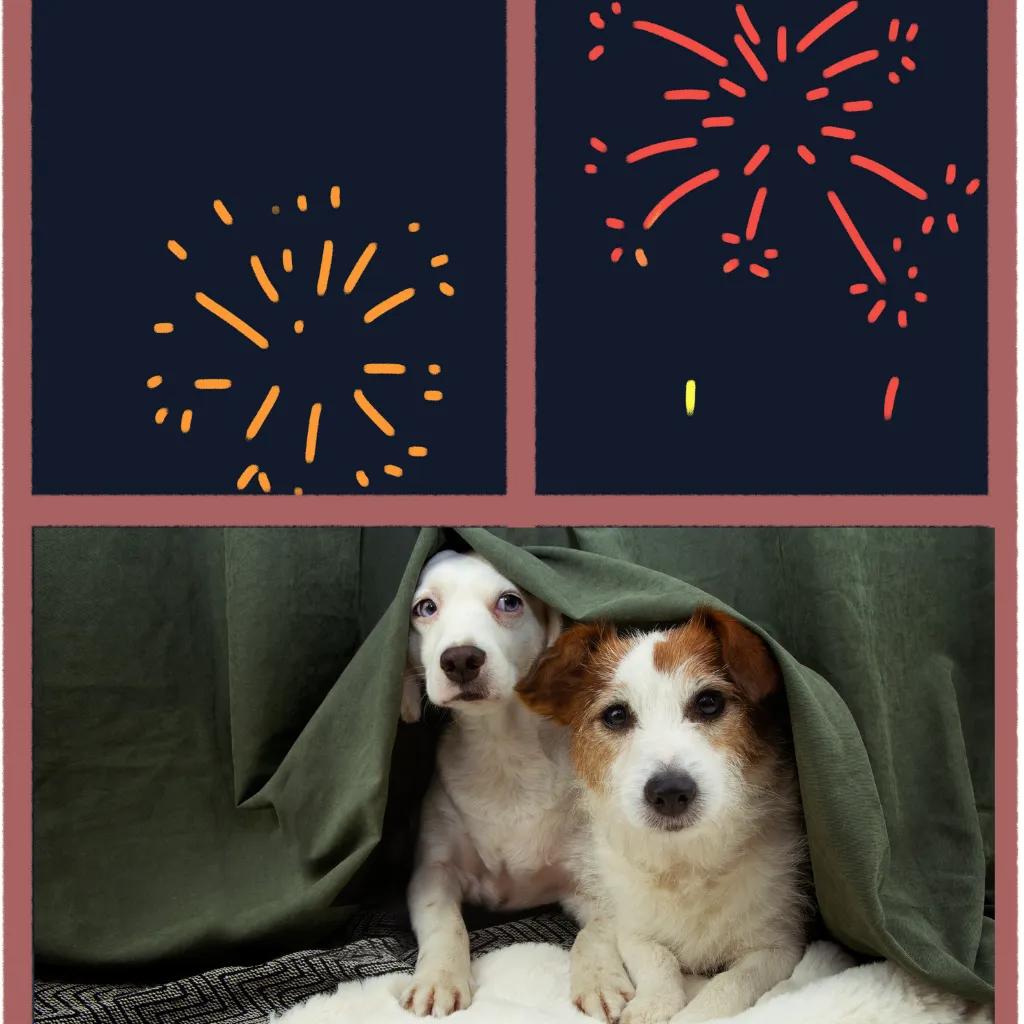Welcome to the Clever Canine Academy Blog!
learn to become your pup's favorite trainer
This is your go-to resource for practical tips, expert advice, and compassionate guidance on navigating the challenges of raising a well-behaved, balanced dog. Whether you're dealing with a new puppy, an overly aroused adolescent, or a fearful, anxious, or reactive dog, you're in the right place.
Explore articles, listen to my Clever Canine Insights podcast, or check out my YouTube channel for even more guidance to help you and your dog enjoy life together!

Fireworks & thunderstorms: 10 essential tips to comfort your canine companion
“Rather than becoming desensitized, a dog’s fight-or-flight reaction can be heightened boom after boom or year after year,” ~Kwane Stewart, DVM Project Street Vet”
As a recent intense thunderstorm swept through my region, it brought with it loud, close lightning that made me jump more than once at its sudden, startling sounds booming overhead. With the static electricity in the air disrupting power, even if just for a brief moment, I couldn't help but think of the countless dogs whose hearts race in fear at such powerful noises, like thunder, fireworks, and gunshots.
With summer's changeable weather patterns and the approach of the July 4th celebrations, the volume of queries from concerned pet parents looking for ways to help their dogs manage their fear and anxiety during these loud, sensory-overwhelming events rises dramatically. Given the heightened senses of our canine friends, these boisterous occasions can often provoke stress, panic, and bewilderment. That's why I've put together this blog post, offering you ten pragmatic steps to prepare your dog for such situations, ensuring they remain as serene and secure as can be.

Dogs hide in a "safe space" that they feel is comforting. Here are 10 Tips to help you prepare and comfort your dog during fireworks & thunderstorms.
1. Maintain calm and positivity
Your dog is highly attuned to your emotions. Try to remain calm and positive during these potentially frightening events. This can help reassure your dog and create a soothing environment for them. You can play calming music to help them relax.
2. Empathize with their fear
We must underscore one crucial fact: the fearful reactions our dogs display during stormy conditions are not a matter of choice. The amygdala, a component of the brain responsible for processing both positive and negative emotions, is part of the central nervous system that cannot be controlled voluntarily. Dogs often react fearfully to loud and unexpected noises, like thunderstorms and fireworks. It's not abnormal, given that such noises can be dangerous in nature. However, problems arise when dogs overreact to these noises, leading to increased anxiety, stress and possible self-harm.
Comprehending our dogs' fear during thunderstorms and firework displays is a critical initial step towards mitigating their anxiety. Dogs have a much superior sense of hearing compared to humans, rendering such thunderous noises tremendously overpowering. Coupled with the shaking vibrations and dazzling flashes, these elements can further heighten their distress
Renowned animal behaviorist, Dr. Nicholas Dodman, articulates this well: "It's
not the noise that scares dogs, it's the noise that comes without any warning.
Dogs are about 50 times more sensitive to sounds than humans."
Signs of storm-related fear in dogs can surface even before the storm has fully materialized. These symptoms may include panting, pacing, whining, trembling, accidental urination or defecation, frantic scratching at walls and floors, attempts to hide or escape, and increased desire for human companionship.
It's worth noting that some dogs, due to their fear, may exhibit re-directed aggression towards other pets in the household. This heightened tension could instigate fights, necessitating you to separate the fearful dog from the rest.
3. Recognize their safe space
Dogs instinctively seek comfort in safe, familiar surroundings during periods of stress. This could be the bathtub, under the bed, a closet, or the basement. Respect their choice of a safe haven and avoid disturbing them when they retreat to these spots.
One of my clients shared their story, their dog, Tank, was really panicking, pacing, whining, running to every room to find a comfortable place. Tank was digging up the bed covers and the owners didn't want them ripped, so they clapped their hands for the dog to get off. The dog then went into the bathroom and hid in the tub. The owners were renovating that room and didn't want the dog in there either, so the male owner picked up the dog to remove him and was severely scratched and bitten all over his arms due to the dog's panic.
It's essential to let them be and let them decide where they feel most secure.
4. Enhance their safe space & practice
In addition to recognizing your dog's chosen safe space, consider making it even more comfortable for them. This can include adding their favorite toys, blankets, and treats to the space. This comforting spot will act as their sanctuary during stressful situations. As part of the desensitization training in the next section, when you place the sounds of thunder or fireworks, encourage your dog to follow you to their "safe space". Reinforce them with treats for laying down calmly. This is not a "stay" exercise so no commands, it is to pair the sound with going to the safe space to help your dog learn they can do this on their own when they need to.
5. Gradual desensitization
It is recommended that you seek the help of a Certified Dog Behavior Consultant or Veterinarian
Behaviorist to help with this process.
To alleviate your dog's fear of loud noises, two proven techniques are systematic desensitization and counter-conditioning
Systematic desensitization involves gradually exposing your dog to the frightening noises, starting at a level that doesn't upset them. For instance, you can play a recording of fireworks or thunderstorms at a very low volume, slowly increasing the volume over time as long as your dog remains calm (Reid, 2019).
Counter-conditioning is about pairing the scary noise with something your dog enjoys, like a favorite treat or toy. This helps change your dog's reaction from fear to anticipation of something positive. In some cases, a new, positive behavior incompatible with the fear response, such as sitting and staying for a treat instead of running and hiding, can also be taught (Horwitz and Mills, 2012).
Many dog owners have reported success using these techniques, with noticeable improvement in their dogs' reactions to fireworks and thunderstorms (Levine et al., 2007; Levine and Mills, 2008; Sheppard and Mills, 2003).
6. Engage with your dog
Engaging your dog in a game, playing with toys, tossing a ball or frisbee or doing tricks that your dog really enjoys and finds exciting is a useful strategy to divert your dog's attention away from the unsettling noises. This helps them associate positive experiences with these sounds.
7. Use pressure wraps or thunder shirts
Thunder shirts can provide relief for dogs experiencing anxiety. They apply gentle, consistent pressure on the dog's body, resulting in a calming effect similar to swaddling a baby. These can be particularly effective for dogs with severe anxiety. Desensitizing your dog to the wrap or shirt BEFORE a storm or fireworks happens is recommended.
8. Consult a vet
If your dog's fear is extreme, consulting with a veterinarian could be necessary. They might recommend medications or other treatment options that could help your dog cope more effectively.
9. Keep dogs indoors
Always keep your dog indoors during fireworks or thunderstorms. This not only minimizes their exposure to the noise and light but also prevents them from bolting if they become frightened.
10. Maintain up-to-date microchip and ID information
Despite the best precautions, there's always a chance that a petrified dog may escape during a noisy event. Therefore, it's crucial to ensure your dog's microchip and ID tag information are current, facilitating a quick reunion should they get lost.
How we can help you
It's critical to recognize that our dogs are not willfully being difficult during storms or fireworks - they're responding naturally to what they perceive as a threat. Understanding their fears and learning how to help them can significantly improve both of your quality of life.
Remember, each dog is unique and may require a specialized approach. For any pet parent needing assistance with their dog's particular fear, I am here to help.
You can schedule a 1:1 online coaching with our Certified Dog Behavior Consultant. This personalized session will allow us to explore your dog's unique needs and devise a tailored strategy to ease their anxiety.
Remember, the goal is not just to survive these loud events, but to create an environment where your dog can feel safe and secure despite the noise. Thank you for taking the first step in understanding and supporting your four-legged family member!
Get our top 7 pro-tips
for life with a relaxed, well behaved dog
Receive daily instructions outlining proven techniques to help you train your dog.
These simple-to-follow lessons can be practiced in just 10 minutes a day.
Learn how to train any behavior.
Learn the overlooked reason why your dog can be difficult to train
Discover why your dog ignores you and what you can do about it
Increase great behaviors and get them consistently even during distracting environments
Eliminating those annoying bad behaviors
Discover what your dog is trying to tell you and how you should respond
Tap into your dog's something and get laser focus
Set up your dog for success everytime and every where you take your dog

